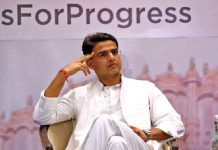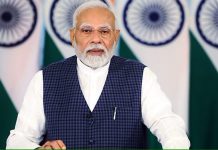
LSTV & RSTV
Modi has also trained his eyes on two other broadcast channels — Lok Sabha TV (LSTV) and Rajya Sabha TV (RSTV) — that are funded with the taxpayers’ money. LSTV, which is under the Speaker of the Lower House, isn’t perceived to be a problem. But RSTV, whose board is headed by Vice President Hamid Ansari, poses a few challenges. With the government in a minority in the Upper House and Ansari’s apparent proximity to the Congress, the channel has remained unbiased and neutral.
Sources feel that until now the government hasn’t overtly tried to ‘manage’ RSTV, but a few ministers and the Sangh Parivar have thrown several bricks at it. “A few ministers continue to crib about its coverage, and the Sangh’s fringe and peripheral elements have attacked the programming,” says one of them. The source quickly adds that RSTV was treated “fairly” in a couple of government projects. “Thus, Modi’s attitude towards RSTV is still in the grey area.”
What may work in Modi’s favour are the internal tensions within the RS Secretariat, and its tussles with a few private broadcasters. Recently, documents were leaked highlighting allegations of corruption, inefficiency and cronyism against Gurdeep Singh Sappal, CEO and Executive Editor, RSTV. A newspaper claimed the channel spent a whopping Rs 1,700 crore in the past four years and its Rs 70-crore annual budget (2014-15) was larger than LSTV and DD channels. RSTV denied the charges and said that its expenditure and annual budget were much smaller.
In its last issue, Tehelka disclosed the role of political favours in crucial RSTV’s appointments. Individuals close to politicians or Sappal’s friends were given jobs at attractive salaries. Contracts were doled out to them without following any procedures. A pil filed by Prashant Bhushan questioned the validity of Clause 6(A) of the RS Secretariat (Method of Recruitment and Qualifications for Appointment) Order, 2009. A source in RSTV denied it.
One cannot say that the government leaked these documents to undermine RSTV, Sappal and Ansari. “Within the channel, the feeling is that this was the work of disgruntled elements in the RS Secretariat, who have legally questioned the appointment of the non-ias and non-iis Sappal as a joint secretary-level
officer. Another source can be the angry private broadcasters, who lost out on contracts that RSTV recently won. Sappal has friends in all the political parties as he has to deal with a number of politicians and ministers,” explains a source in the MIB.
There is no guarantee that the ruling regime will not use the allegations and charges to get rid of Sappal and some of his other friends in RSTV in the near future. The fact remains that if Modi gets his ‘own’ man in RSTV, he will have total control over the public service media.
Privately-held media
Over the past two years, the BJP has subtly forced the private media to fall in line. In the run-up to the national election, media owners either asked their liberal editors to quit or pushed them to seek other pastures. These include Siddarth Varadarajan, formerly of The Hindu, who was accused of underplaying Modi’s coverage. N Ravi, the new editor said Varadarajan gave instructions to the news desk not to take Modi stories on Page 1 of the newspaper. In an interview with Tehelka in 2013, he clarified that his rule was that rally stories of either Modi or Rahul Gandhi would be on the front page in local editions but would make to the front page nationally only if they were newsworthy.
Such events sent the ‘right’ signals to TV channels and newspapers. After May 2014, Modi’s coverage got a massive makeover. For months, no one dared to oppose his policies or question them critically. The Modi wave, which subsumed the electorate, deluged the news media. The latter’s coverage of the government became rosy and culminated in a frenzied Modi-media honeymoon.
It was followed by the crackdown on LeakGate, or the apparent leaks of sensitive official documents that compromised the nation’s security. Thieves, journalists and corporate managers were arrested and questioned to expose the unsavoury nexus between big business, big media, and big bureaucrats. Government documents from key ministries such as power, telecom, oil and gas and defence were routinely leaked to earn money, manipulate stock markets and help foreign spies.
Ministers and bureaucrats were told to stem the leaks; they were, in fact, asked not to meet journalists. Only official spokespersons could do so. To be fair to Modi, routine decisions taken by the ministries were highlighted on their websites. Journalists, who thrived on the behind-the-scenes information and exclusives, found themselves in the lurch. The media couldn’t access the information that the government didn’t wish to give, or wanted to hide. Private media journalists were banned from Modi’s foreign trips; they had to pay their way through to cover these events.
Community radio
For Modi, radio is the darling among the various media platforms. It has the reach — AIR is heard in remote areas and by people who are poor and cannot afford a TV or a mobile. It is a medium that suits Modi — only his ‘messianic’ voice is heard by the citizens. Most importantly, what happens on radio, unlike DD, is not watched, analysed and criticised by the mainstream media. The reason: Urban journalists only listen to private FM channels or AIR FM Gold, and not to air news. This is why he chose AIR to air his regular ‘Mann ki Baat’ talk with the people.
However, Modi is interested in a 360-degree media strategy, which uses every available opportunity, including social media, to propagate his views, messages and vision. Hence, he was keen to target community radio (CR), which comprises localised radio stations, but whose limited reach goes to the people who are poor, marginalised and have little access to the media content from other sources. A few months ago, the 180 CR stations were “advised” by the MIB to create local content and programmes around Modi’s hyped schemes such as Swachh Bharat, Beti Bachao Beti Pradhao and Jan Dhan.
At the recent national CR Sammelan, held in New Delhi, the advisory was questioned by a few stations. The official reply was that CR should not view Modi as a representative of a certain party or a specific political regime. He was the Prime Minister, a national figure, and, therefore, his pet schemes needed to be talked about by media, including CR. When pushed into a corner, the officials gave a veiled threat — everyone knew the meaning of the word “advised” used in the memo sent to the CR stations. Just to rub in the point further, the Intelligence Bureau has begun to ring up the various CR stations to ask questions about their programming, their reach and catchment areas and the number of listeners that they have.
Insiders say that this exercise is being conducted for the first time. Another official directive asked the bigger stations to submit recordings of their programmes.
CR owners claim that both the moves are aimed to convert their stations into official propaganda tools. However, they have little room to manoeuvre. They are financially dependent on the government; they can allot five minutes per hour on advertising but the bulk of their revenue comes from davp advertisements, or those released by the various ministries. In addition, the government has Rs 100 crore corpus to fund CR but this may come with official or hidden riders.
Clearly, PB, DD and AIR may willingly or unwillingly turn into ‘his master’s voice’. Private media may become fence sitters, but are likely to favour Modi government or face its wrath. The CR may have no option and future licences may be doled to ‘friends of BJP’. In a nutshell, in a few years, Modi’s media machine may run like an efficient and well-oiled one.
editor@tehelka.com













